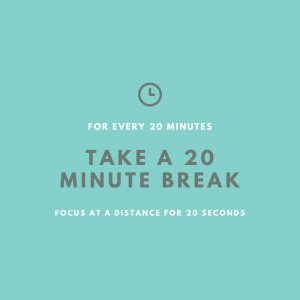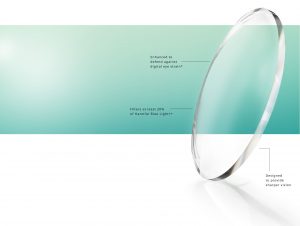Digital eye strain: How to help the symptoms
November 2, 2020
We are a digital people. Now more than ever we spend our days viewing computer screens and digital devices. Age no longer matters, as people young and old become more and more dependent on computers for daily life. This can mean we are much more efficient. Now work can happen anytime and anywhere. Learning isn’t just in classrooms anymore. We stay connected 24/7. But it also means our eyes and vision can suffer with digital eye strain.
Digital eye strain is a real thing and something you might be hearing a lot about right now. What does it really mean though, why does it happen, and what can we do about it?
What is digital eye strain?
Eye strain, eye fatigue, blurry vision, headaches and dry eye can all be symptoms of digital eye strain. They all can happen with in an increase in demand on the visual system with an increase in digital device use.
Why does it happen?
For near work, like reading or looking at a computer screen or phone, our eyes have to adapt to let us see clearly. This change in the eye muscles allow us to see focused and single, instead of blurry with double vision. It takes a lot of effort for our eyes to hold in this position and focus long term. When we do it for many hours a day the muscles that make it possible become tired and sometimes even sore, causing fatigue and headaches. Eventually they become so tired that they can’t function in the same way and we experience blurry vision or sometimes even double vision.
Another common symptom of digital eye strain is dry eye. When we are viewing computers and digital devices our blink rate can decrease by as much as 50-60%! Blinking maintains the surface of our eyes, keeping our eyes comfortable AND keeping our vision clear. By not blinking regularly our eyes can feel gritty and dry, as well as suffer from fluctuating vision. Even more, as the time we spend in this decreased blink rate increases the odds of chronic, or long-term, dry eye increases. The oil glands that line our eyelids release oil with every blink. Less blinking means less oil release which means the oil thickens over time. Thick oil doesn’t release well with a blink. Now we have a recipe for even more severe dry eye symptoms.
What can we do about it?
It would be nice to say, “Just spend less time on digital devices!” but let’s be realistic. Yes we can pay more attention to mindless scrolling through social media, hours of Netflix binging and too many hours of video games. Some of the time we spend on digital screens just isn’t going anywhere though. There are some things that you can do to help avoid digital eye strain.
- Implement the 20/20/20 rule when viewing screens. For every 20 minutes of time spent viewing a digital screen take a 20 second break and look in the
 distance (20 feet or farther.) Distance viewing is out default relaxed position (assuming you are wearing the correct prescription, but that is for another blog post.) By looking in the distance for 20 seconds you are relaxing your focus and eye muscles. You are also allowing your blink rate to go back to normal. There are lots of apps available to remind you to take breaks from your screen. Try one of those or just set a timer on your phone for 20 minutes.
distance (20 feet or farther.) Distance viewing is out default relaxed position (assuming you are wearing the correct prescription, but that is for another blog post.) By looking in the distance for 20 seconds you are relaxing your focus and eye muscles. You are also allowing your blink rate to go back to normal. There are lots of apps available to remind you to take breaks from your screen. Try one of those or just set a timer on your phone for 20 minutes. - Be sure you have the right working distance and height for your monitor. The best working distance for computer screens is arm length or further. When seated stretch out your arm in front of you. If your monitor is at arm length you should just barely be able to touch the screen or not be able to touch it at all. The top of your monitor should be about 1-2 inches below your line of sight at the tallest.
- Use preservative free artificial tears every few hours for symptoms of dry eye. Artificial tears shouldn’t be used in place of other remedies, but when you’ve inevitably pushed it too far they can help with symptoms of dry eye such as gritty, sandy eyes, burning or stinging and blurry vision that comes and goes with a blink.
- Consider if glasses with a blue UV filter might be a good option for you. Blue light is a short, high energy wavelength of light that comes from several
 sources. Most notably blue UV comes from the sun but it also comes from back lit LED sources such as computer screens, smartphones, LED lights and televisions. Essentially we are bathed in blue light all day long. For many people this blue light is disruptive, almost like “noise” that has to be filtered away because our brains process it like it is glare. By filtering some of that blue UV with lenses or lens coatings we decrease the amount of work our brain has to do to filter it out and, for some people, that means more comfortable vision.
sources. Most notably blue UV comes from the sun but it also comes from back lit LED sources such as computer screens, smartphones, LED lights and televisions. Essentially we are bathed in blue light all day long. For many people this blue light is disruptive, almost like “noise” that has to be filtered away because our brains process it like it is glare. By filtering some of that blue UV with lenses or lens coatings we decrease the amount of work our brain has to do to filter it out and, for some people, that means more comfortable vision.
Anytime you experience eye or vision related symptoms the first step is to see your eye doctor. They will discuss your computer habits, run tests to see if there is an underlying vision issue, and give you strategies for reducing your symptoms leaving your with happier and healthier eyes!

Add a comment
0 Comments